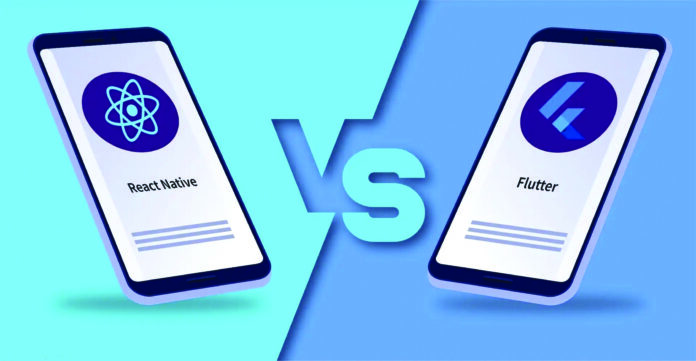By: Shahzaib Asad and Yaqoob Ali Baloch
The need for mobile applications has skyrocketed in the current digital environment. In order to serve people across many platforms, businesses look for economical and effective solutions. With cross-platform development frameworks, developers can create code once and have it run on multiple operating systems, making this a popular option. Flutter and React Native are two of these frameworks’ most well-known competitors. The architecture, performance, usability, and ecosystem of these frameworks are all thoroughly compared below.
In 2017, Google released Flutter, an open-source UI software development kit (SDK). From a single codebase, developers may create natively compiled desktop, web, and mobile applications. Using Dart as its programming language, Flutter offers a wide range of configurable widgets that replicate the built-in features of iOS and Android. Another open-source framework that facilitates cross-platform development is React Native, which was unveiled by Facebook in 2015. It makes use of JavaScript and React, a well-known user interface toolkit, to develop iOS and Android apps. React Native ensures near-native speed by utilizing a bridge method to connect JavaScript code with native components.
A development framework’s flexibility and performance are greatly influenced by its architecture. The architecture of Flutter is layered. Its central component is the Flutter engine, which is C++-based and handles input, generates graphics, and makes platform-specific APIs easier to communicate with. High performance is guaranteed by the compilation of Dart into native code. Furthermore, Flutter’s widget-based methodology removes the need for platform-specific components, enabling it to provide a unified user interface. React Native facilitates communication between native components and JavaScript code by means of a bridge. Although this architecture guarantees that developers can use native modules when needed, performance bottlenecks may be introduced by the bridge, particularly in complicated applications. In keeping with its JavaScript heritage, React Native’s architecture places a strong emphasis on modularity and code reuse.
When choosing a cross-platform framework, performance is crucial, especially for apps that need fluid animations and quick interactions. Flutter has a performance advantage due to its direct compilation to native ARM code and dependence on Dart. Flutter lowers latency and guarantees a flawless user experience because it communicates with native components without the need for a bridge. It is appropriate for graphically demanding applications because of its rendering engine, Skia, which produces steady 60 fps or even 120 fps animations. Although React Native works well for the majority of use cases, applications with intricate logic or animations may experience slower performance due to their reliance on the JavaScript bridge. Performance can be enhanced by optimizations such as the use of Hermes, a JavaScript engine designed specifically for React Native. When compared to Flutter, React Native apps may still occasionally lag.
A framework’s uptake and project schedules are greatly influenced by how simple it is for developers to understand and utilize. Dart may be comparatively simple for developers who are accustomed to object-oriented programming languages like Java or C++. Newcomers can find plenty of resources in Flutter’s lively community and comprehensive documentation. Productivity is increased by the “hot reload” feature, which allows for quick visualization of changes.
However, developers used to a different methodology may find the widget-heavy framework overwhelming. Because JavaScript is so widely used, React Native’s use of it makes it available to a wider audience. It will be especially easy for those who have worked with React or web development before. React Native has a “hot reload” capability, just like Flutter. For novices, however, integrating native modules and navigating the bridge architecture can be difficult.
The final decision between Flutter and React Native is based on the long-term objectives, team experience, and project needs. Businesses and developers can make wise decisions to produce high-quality apps quickly by being aware of the subtleties of these frameworks
The ecosystem’s robustness can have a big impact on how quickly and how well a framework develops. With so many plugins and packages on Pub.dev, the Flutter ecosystem is expanding quickly. Flutter is actively maintained by Google, so developers should anticipate regular updates and enhancements. However, compared to more established frameworks, Flutter might feature fewer third-party libraries due to its relative infancy. With a vast array of libraries and tools, React Native has a well-developed ecosystem. Developers have more options and flexibility thanks to its interaction with well-known JavaScript libraries and frameworks. Developers must carefully consider their selections because third-party libraries can differ in terms of quality and upkeep. Third-party solutions, forums, and tutorials are guaranteed to be available when there is a robust developer community. Compared to React Native, Flutter has a smaller yet very active community. Community-driven events and content have increased as a result of Google’s commitment in Flutter and its rising popularity. React Native, one of the first cross-platform frameworks, has a sizable and established user base. Stack Overflow, GitHub repositories, and forums are easy ways for developers to solve common issues.
The particular needs of a project determine which framework is best. Applications that need unique user interfaces, fluid animations, or cross-platform compatibility— including desktop and web— are best suited for Flutter. Flutter has been effectively employed by businesses like Alibaba and BMW for their applications. When code reuse and quick prototyping are top concerns, React Native performs exceptionally well. It is appropriate for enhancing legacy applications due to its capacity to interface with native code that already exists. Well-known applications like Instagram and Airbnb have made use of React Native’s features.
With their own advantages and disadvantages, Flutter and React Native are both strong cross-platform development tools. Flutter is a great option for apps that require a high level of visual appeal because of its excellent performance, reliable rendering engine, and consistent user interface. However, React Native’s well-established ecosystem and JavaScript base provide flexibility and user-friendliness, particularly for developers with prior web development experience.
The final decision between Flutter and React Native is based on the long-term objectives, team experience, and project needs. Businesses and developers can make wise decisions to produce high-quality apps quickly by being aware of the subtleties of these frameworks.























